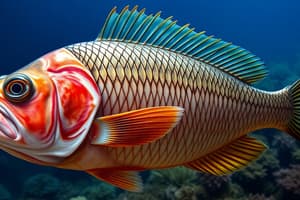Podcast
Questions and Answers
What is the estimated average spacing of whale falls along migration routes?
What is the estimated average spacing of whale falls along migration routes?
- 12 km (7.5 mi (correct)
- 5 km (3.1 mi
- 690,000
- 2000 years
What type of organisms has been observed at deep-sea whale fall sites?
What type of organisms has been observed at deep-sea whale fall sites?
- Octopus and giant isopods
- Squat lobsters and polychaetes
- Prawns, shrimp, and lobsters
- All of the above (correct)
What is the main factor that allows whale carcasses to sink to the seafloor quickly and relatively intact?
What is the main factor that allows whale carcasses to sink to the seafloor quickly and relatively intact?
- Cold temperatures
- High hydrostatic pressures
- Decompositional gases
- A lack of scavengers (correct)
Flashcards are hidden until you start studying
Study Notes
- Whale falls are sites where the carcass of a whale has fallen onto the ocean floor at a depth greater than 1,000 m (3,300 ft).
- On the sea floor, these carcasses can create complex localized ecosystems that supply sustenance to deep-sea organisms for decades.
- Whale falls were first observed in the late 1970s with the development of deep-sea robotic exploration.
- Since then, several natural and experimental whale falls have been monitored through the use of observations from submersibles and remotely operated underwater vehicles (ROVs).
- Deep sea whale falls are thought to be hotspots of adaptive radiation for specialized fauna.
- Organisms that have been observed at deep-sea whale fall sites include octopus, giant isopods, squat lobsters, polychaetes, prawns, shrimp, lobsters, hagfish, Osedax, crabs, sea cucumbers, and sleeper sharks.
- New species have been discovered, including some potentially specializing in whale falls.
- It has been postulated that whale falls generate biodiversity by providing evolutionary stepping stones for multiple lineages to move and adapt to new environmentally-challenging habitats.
- Researchers estimate that 690,000 carcasses/skeletons of the nine largest whale species are in one of the four stages of succession at any one time.
- This estimate implies an average spacing of 12 km (7.5 mi) and as little as 5 km (3.1 mi) along migration routes.
- Whale falls are able to occur in the deep open ocean due to cold temperatures and high hydrostatic pressures.
- In the coastal ocean, a higher incidence of predators as well as warmer waters hasten the decomposition of whale carcasses.
- Carcasses may also float due to decompositional gases, keeping the carcass at the surface.
- The bodies of most great whales (which includes sperm whales and many species of baleen whale) are slightly denser than the surrounding seawater, and only become positively buoyant when the lungs are filled with air.
- When the lungs deflate, the whale carcasses can reach the seafloor quickly and relatively intact due to a lack of significant whale fall scavengers in the water column.
- Once in the deep-sea, cold temperatures slow decomposition rates, and high hydrostatic pressures increase gas solubility, allowing whale falls to remain intact and sink to even greater depths.
- The amount of carbon tied up in a typical single whale carcass (about two tonnes of carbon for a typical 40-tonne carcass) is roughly equivalent to the amount of carbon exported to a hectare of abyssal ocean floor in 100–200 years.
- This amount of organic material reaching the seafloor at one time creates a pulse equivalent to about 2000 years of background carbon flux in the 50 square meters of
- Whale falls are distributed throughout the ocean and are often concentrated near migration routes.
- Mussels and vesicomyid clams belong to groups that harbor chemosynthetic bacteria, which can draw energy from inorganic chemicals, such as sulfur.
- Before their presence was discovered at whale falls, the only known habitats of these groups were sunken wood and hydrothermal vents.
- Osedax, a genus of deep-sea polychaete worms, act as ecosystem engineers by excreting acid to erode whale bones and absorbing the nutrients trapped within.
- This enhances biodiversity in the deep sea by increasing the water diffusion into the matrix of bones and facilitating colonization of the bone matrix by rarer species.
- Whale falls provide a rich source of nutrients for marine ecosystems
- The four stages of decomposition associated with whale falls vary in duration and overlap with one another
- Smaller cetaceans, such as porpoises and dolphins, do not undergo the same ecological succession stages due to their small size and lower lipid content
- Researchers believe the presence of Osedax worms may also be a contributing factor in the observed successional differences.
- Whale falls are a type of sedimentary deposit that are composed of the remains of large marine mammals that have died from natural causes.
- The remains of these animals can often be found in high concentrations near the carcass itself, which is a key factor in their ability to support deep-sea communities.
- Whale falls are unique in that they are the only type of sedimentary deposit that is known to contain chemosynthetic-only organisms.
- The removal of large whales has been suggested to have an effect on the biological pump, leading to a reduction in the amount of whale falls that are present in the deep sea.
- Whale falls are not the only type of sedimentary deposit that can support deep-sea communities, and other types of falls have been observed to have similar communities.
Studying That Suits You
Use AI to generate personalized quizzes and flashcards to suit your learning preferences.




